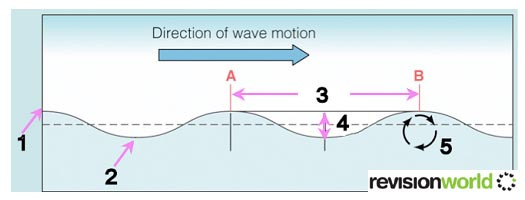Most work along coasts is done by waves. Waves are created by the transfer of energy from the wind blowing across the surface of the sea.
The size and strength of individual waves depends on:
- the velocity or speed of the wind
- the period of time that the wind has been blowing
- the maximum distance over the sea that the wind can blow (the fetch)
Local or sea waves travel only short distances and are created by local winds. Swell waves travel huge distances and are created by large storms in the middle of the oceans.
Wave Properties

- 1 = wave crest
- 2 = wave trough
- 3 = wave length
- 4 = wave height
- 5 = circular movement of wave particles
Wave period = time taken for a wave to travel one wave length
Wave velocity = speed of movement of wave crest in a given period of time
Wave steepness = the ratio of the wave height to the wave length
Wave energy is proportional to the wave length times the square of the wave height
In deep water, wave particles follow a circular motion. In shallow water (once the depth becomes less than a quarter of the wave length), the wave encounters friction with the sea bed and the circular motion changes to an elliptical motion.
The top of the wave continues to move forward faster than the base of the wave causing the wave to break. The position of the plunge line will vary according to changing conditions.
As a wave breaks, water rushes up the beach (swash) and is then carried back down the beach by gravity (backwash). The amount of percolation of the swash depends on the porosity of the beach material.
When waves approach a coast with headlands and bays, the waves are refracted. This means that the wave crests are bent to become increasingly parallel to the coast. As the wave crest approaches the shallow water around a headland, friction slows the wave but that part of the wave crest in the deeper water of the bay, continues to move forward at a faster speed, so turning the wave crest.
Lines drawn at right-angles to the wave crests (known as orthogonals) shown the bending of the wave crests by refraction. The effect of refraction is to concentrate wave energy on the protruding headlands.
Longshore currents carry the eroded headland material and deposit it in the bays. In time, the coastland becomes less irregular as headlands are eroded and bays filled in.
Constructive and Destructive Waves
There are two types of waves that affect the coast:
Constructive waves
- These are usually low waves with a long wave length and along wave period (6 – 8 waves per minute). They are often swell waves.
- Constructive waves steepen slowly as they approach a beach.
- The wave breaks gently, the swash moves up the beach slowly and water percolates quickly into the sand.
- The backwash is usually weak.
- These waves slowly push material up the beach creating sandy ridges or berms (high sandy ridges), and ridges and runnels (small ridges and depressions on the lower beach).
Destructive waves
- High with a short wave length and a short wave period ( 10 – 14 waves per minute). They are often local waves.
- Destructive waves steepen quickly as they approach a beach.
- The waves plunge with greater force on to the beach.
- The swash is short and there is a more effective backwash which drags material down the beach.
- The overall effect is that whilst some large storm waves may throw shingle to the top of the beach and form a storm ridge, most material is dragged downwards to form a breakpoint bar.
